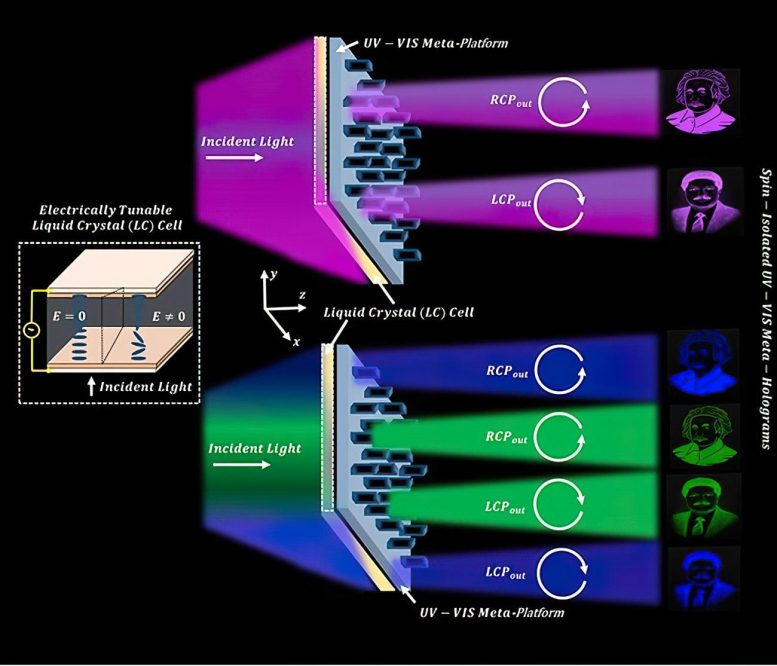
Researchers have developed a method for generating meta-holograms in both the visible and ultraviolet spectral regions, overcoming prior limitations. They also devised a way to encode two distinct holographic phase profiles onto a single metasurface, leveraging polarization characteristics and liquid crystal, leading to potential applications in security technologies. Credit: Nanoscale Horizons
The term ‘meta’ signifies the notion of going beyond or transcending. When this idea is related to materials, we refer to ‘metamaterials’, which are synthetically produced substances exhibiting properties that aren’t naturally present in our surroundings.
Metasurfaces, recognized for their lightweight and slender properties, have captured significant attention as potential constituents to be integrated into mobile augmented reality (AR) and virtual reality (VR) apparatuses to facilitate holographic generation.
Nonetheless, it is important to note that metasurfaces have inherent limitations, such as their restricted capacity to store information and their capability to generate holograms solely within the visible spectrum.
The research team comprising Professor Junsuk Rho from the Department of Mechanical Engineering and the Department of Chemical Engineering and Joohoon Kim from the Department of Mechanical Engineering at Pohang University of Science and Technology (POSTECH) have achieved the generation of meta-holograms applicable to both the visible and ultraviolet spectral regions.
(Left) When an electric field is not applied, the liquid crystal cells align linearly, causing the light to spin clockwise. Conversely, when an electric field is applied, the arrangement of the liquid crystal cells becomes non-linear, resulting in the light spinning in a different direction. (Right) The new approach facilitates the generation of two distinct holograms by designing them to be responsive to the direction of the light. Credit: POSTECH
The research findings have been published in the inside front cover of Nanoscale Horizons, an esteemed international journal.
The restriction of hologram generation to the visible spectral range has been primarily attributed to light absorption exhibited by most objects in the ultraviolet regime.
However, the research team has effectively addressed this challenge by incorporating a thin layer of specially formulated gas compositions into the metasurfaces, thereby achieving significant improvements in holographic transmission efficiency within both the visible and ultraviolet regimes.
Furthermore, the team has accomplished the encoding of two distinct holographic phase profiles onto a single metasurface. The polarization characteristics of light govern its propagation through space.
Leveraging this phenomenon, the team’s approach enables the provision of holographic information both for clockwise circularly polarized light and counter-clockwise circularly polarized light, effectively doubling the amount of information encoded onto metasurfaces.
To facilitate practical implementation, the team employed liquid crystal, a commonly used component in cellphones and LCD displays, which enables convenient manipulation of the light’s spin direction. The experimental results demonstrated that in the absence of an electric field, the light exhibits clockwise spinning, thereby generating a type A hologram.
Conversely, the application of an electric field induces a different light spinning direction, resulting in the generation of a type B hologram. In essence, the research team engineered a device capable of presenting distinct holograms based on the presence or absence of an electric field.
Professor Junsuk Rho – who led the research – emphasized this breakthrough by commenting, “This study is significant in that it overcomes the limitations associated with meta-holograms solely applicable to the visible regime and we have achieved the concurrent generation of meta-holograms in both the visible and the UV domains.” He added, “This proposed metasurface can have promising applications in security technologies such as anti-counterfeiting measures, identifications, and passports.”
Reference: “Spin-isolated ultraviolet-visible dynamic meta-holographic displays with liquid crystal modulators” by Aqsa Asad, Joohoon Kim, Hafiz Saad Khaliq, Nasir Mahmood, Jehan Akbar, Muhammad Tariq Saeed Chani, Yeseul Kim, Dongmin Jeon, Muhammad Zubair, Muhammad Qasim Mehmood, Yehia Massoud and Junsuk Rho, 18 April 2023, Nanoscale Horizons.
DOI: 10.1039/D2NH00555G
The study was conducted with the support from the STEAM Research Program (Center for Nano-optics-based Smart Data Security Technology) of the National Research Foundation of Korea funded by the Ministry of Science and ICT and a program of POSCO’s Industry-Academic Integrated Research Center.
>>> Read full article>>>
Copyright for syndicated content belongs to the linked Source : SciTechDaily – https://scitechdaily.com/breaking-barriers-in-holography-revolutionary-metamaterials-expand-spectrum-possibilities/















![[News] Japan Develops 10nm Nanoimprint Technology, with Potential to Tackle EUV Bottleneck – TrendForce](https://earth-news.info/wp-content/uploads/2025/12/329851-news-japan-develops-10nm-nanoimprint-technology-with-potential-to-tackle-euv-bottleneck-trendforce-360x180.jpg)
















